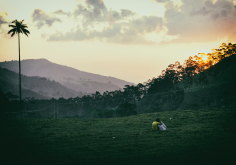BOGOTA — Colombia is dangerous. Universities are bad. Drugs are prominent and cocaine is everywhere. Does that sound familiar? For many outsiders, the main source of information on Colombia is the series “Narcos”, which gives an acute misrepresentation of the dangers of life in most parts of the country. While I have been living in this country, people have asked me how I felt about wasting my education at a bad university. I was surprised by the almost universal wall of prejudice that surrounds Colombia. Bogota provides many opportunities. Before arriving in this amazing country, I was unaware of what kind of everyday “dangers” I would face here. For me, Colombia is “dangerous” mainly because once you arrive, you will never want to leave.
It’s “dangerous” how early we have to wake up here in order to get to school safely and on time. Although nobody has been able to explain why, university starts at the (ungodly) hour of 7 a.m. in Colombia. This means that many of my friends need to wake up between 4:30-5:30 a.m. in order to arrive on time.
The lack of quick and efficient public transportation creates a “danger” of getting to work late. With a total of 11 million inhabitants, Bogota is one of the 30 biggest cities in the world, yet it doesn’t have a metro. The current system of public transportation is exclusively made up of buses. The old buses leave clouds of black smog every time their engines turn into gear, and the new ones can become overcrowded.
‘Rolos’ (people who live in Bogotá), as a result, are in “danger” of being late all the time, often using the excuse of ‘trancón’ (Traffic). “Being on time” in Bogota means something very different than what I have been taught. Let’s say you meet up at 3:30 p.m. At 4 p.m., your friend will message you saying that he or she just got in the taxi. At 5 p.m. your friend, who only lives five minutes away by cab, arrives. Fortunately, this doesn’t happen all of the time. Yet, the general lateness of 15-45 minutes is deeply ingrained in the culture. It results in a planned lateness that can be applied to many aspects of life here: events, flights and even group projects for class; some university professors even decide to start the class 10-20 minutes after the official time!
The education system in Colombia has proved to be dangerous for my GPA. My classes are all in Spanish and, despite studying here for nine months and speaking entirely Spanish, I find them significantly more challenging than those at Fordham. I’ve even found the grading system to be much stricter than Fordham’s, possibly because the exchange university, Pontificia Universidad de Javeriana (PUJ), is the fourth best in the country. What I am learning in Colombia, be it through the people or even through a university course about creativity and innovation, is more valuable than the letter grade with which one could label it.
Colombia, of course, has an element of traditional danger. It is notorious for Pablo Escobar, guerrilla warfare (FARC, ELN) and its cocaine export. This dark part of its history has visible effects; for example, displaced farmers who, after having their properties forcefully taken away by guerrilleros, moved to the cities without any money or housing opportunities.
Colombia also suffers from the stereotyping by foreigners. When some hear ‘Colombia’, they think drugs and incompetence, but in reality, most Colombians are extremely aware of the calamities that the drug trade has caused. Many disapprove of drug use because it finances a conflict that has terrorized their home with civil unrest, corruption and guerrillaa activity for over a century.
The real danger in Bogota, arguably the least safe big city in Colombia, is to “dar papaya” — a Colombian expression used to describe situations resulting from neglect. When someone ‘gives papaya’, they are not aware of their surroundings. They may walk in the wrong neighborhood at the wrong time or be walking down the street with their eyes gazing down at their iPhone. For outsiders, the possibility of being assaulted at knife point seems like a big risk. However, it’s easily avoidable when you follow a general guideline, take precautions and most importantly, don’t give papaya.
The beauty I have found in this country has made all of the “dangers” seem small. The people here are endlessly kind, and the culture is rich and beautiful. Foreigners are rare, and Colombians love to learn about different cultures. My inconcealable Western look, combined with the infrequency of foreigners, means that almost everywhere I go people take interest in talking to me and finding out what I am doing in their country. One thing you can count on is that the people here are the kindest and, according to a survey done by Worldwide Independent Market research in January, the happiest on earth.
To the outside world, little is known of Colombia and rumors about it should be taken with a healthy portion of skepticism. Danger is present, there is no doubt about it, but it is very avoidable and worth it to visit this country.





